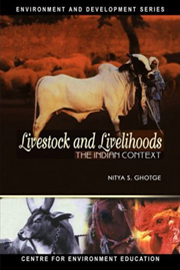Book contents
- Frontmatter
- Foreword
- Acknowledgements
- Contents
- Preface
- Chapter 1 The Beginning …
- Chapter 2 Patterns of Livestock rearing
- Chapter 3 Traditional Practices in Animal Rearing
- Chapter 4 Emerging Trends in Livestock Rearing
- Chapter 5 It must not End: Towards an Alternative Policy
- Chapter 6 Reorienting Ourselves
- Chapter 7 Framework for An Alternate Policy
- References
- Index
Chapter 4 - Emerging Trends in Livestock Rearing
Published online by Cambridge University Press: 26 October 2011
- Frontmatter
- Foreword
- Acknowledgements
- Contents
- Preface
- Chapter 1 The Beginning …
- Chapter 2 Patterns of Livestock rearing
- Chapter 3 Traditional Practices in Animal Rearing
- Chapter 4 Emerging Trends in Livestock Rearing
- Chapter 5 It must not End: Towards an Alternative Policy
- Chapter 6 Reorienting Ourselves
- Chapter 7 Framework for An Alternate Policy
- References
- Index
Summary
Colonization and its Effects on Livestock Rearing
Rulers and dynasties changed and systems developed and evolved as did rural livelihoods but the major changes in livestock rearing practices came with the advent of colonization when the rulers came from a different continent, a different culture, a different race. We now trace the possible impact of colonization on the different livestock rearing practices described earlier.
The effect of colonization on livestock species of domination…elephants, camels and horses
Even as power changed hands, elephants, camels and horses continued to be the species, which symbolized power, wealth and domination. Emperors and kings of the vast and rich subcontinent rode imperiously astride elephants while their retinue rode caparisoned horses and camels. The Mughal emperors regularly bred and reared elephants. According to Vijaylakshmi and Vaidya (1995), the Maharaja of Nepal, Jung Bahadur, till a hundred years ago owned a thousand elephants. This splendour and pomp appealed to the British when they first came to India. Moorhouse (1985) for example, points out to the number of colourful reports of the Grand Durbar where Maharajas and lesser chieftains came borne on these animals whose accoutrements alone were each worth a prince's ransom in precious metals and stones. The daily allowance in Bengal for a full size elephant as decreed by the British Government was 400 lbs of green fodder viz., grasses, branches of trees, sugarcane or in lieu of the above, 200 lbs of dry fodder.
- Type
- Chapter
- Information
- Livestock and LivelihoodsThe Indian Context, pp. 58 - 99Publisher: Foundation BooksPrint publication year: 2004

